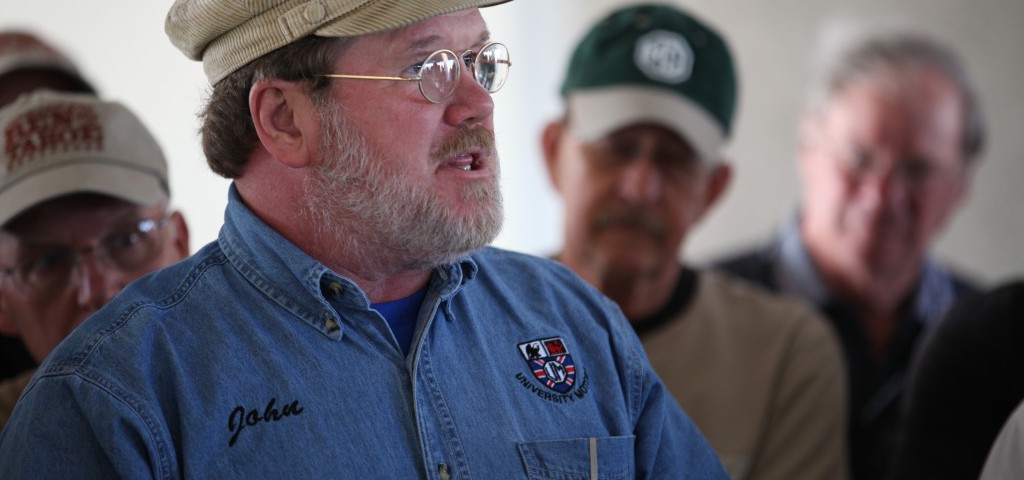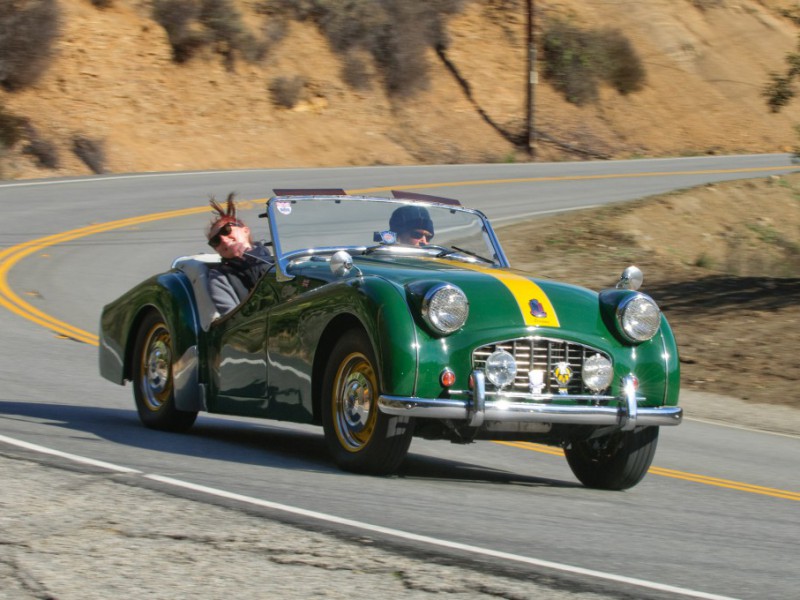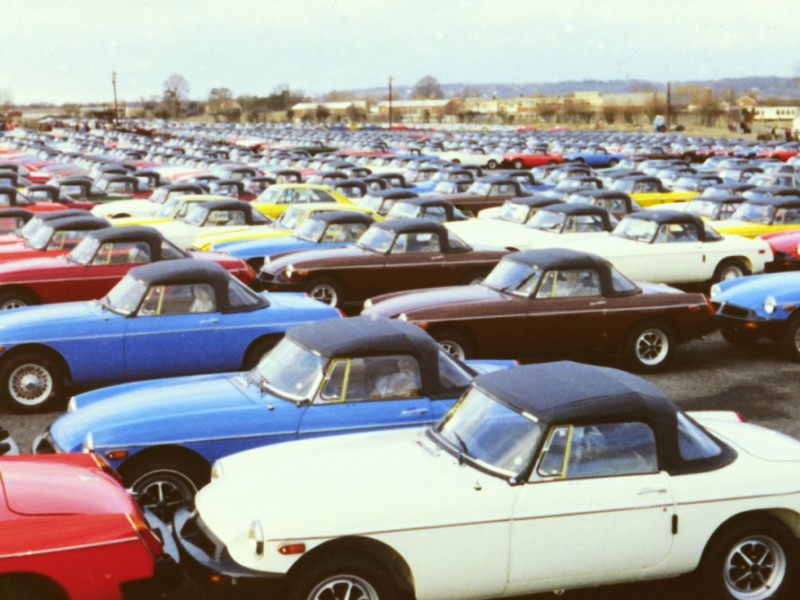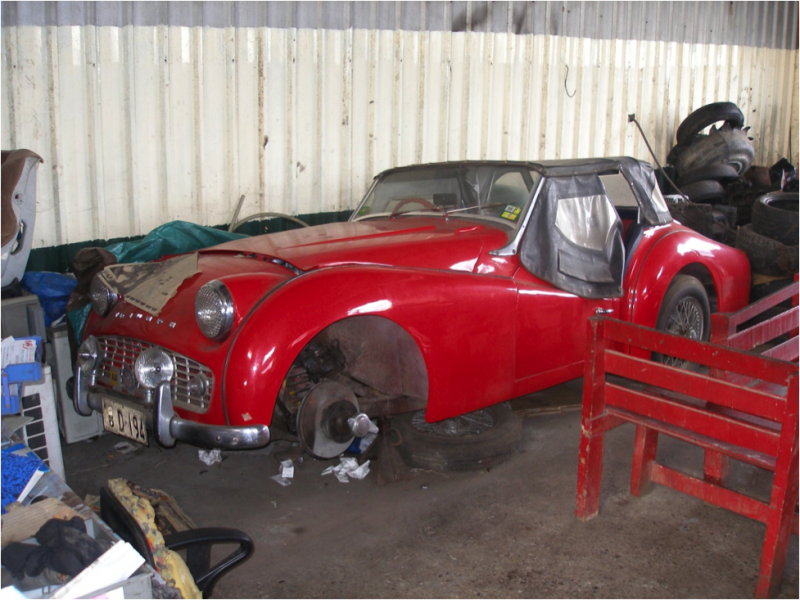When I arrived home on a Saturday late in July 1968, driving my MGTD, the first words out of my father’s mouth were, “So, you quit college?” Indeed I had. I told my parents that I would serve in the Army (there was no alternative) and continue college upon my discharge. I served 22 months including 364 days in Vietnam, both at USARV HQ and the 25th Infantry Division HQ, where I was a clerk (G-3) with occasional guard duty on the bunker line.
 Lying atop my bunk in the bay at HHC at Fort Knox, I read, read again and re-read section B in the TD workshop manual, scrutinizing the cut-away views until I understood the function of the SU carburetors. I read the remainder of the workshop manual, too. Accompanying me on my year’s duty to Long Binh and Cu Chi was my trusty Moss Motors catalog. For those months I dreamed of restoring my TD. The week of my discharge at Oakland, CA, I travelled to Goleta to purchase all the parts necessary from Glen Adams at the front counter of Moss Motors. My several attempts to continue higher education were thwarted by the restoration and by working on other MGs. Quite simply, MG had become my mistress and she was not to be denied my absolute devotion.
Lying atop my bunk in the bay at HHC at Fort Knox, I read, read again and re-read section B in the TD workshop manual, scrutinizing the cut-away views until I understood the function of the SU carburetors. I read the remainder of the workshop manual, too. Accompanying me on my year’s duty to Long Binh and Cu Chi was my trusty Moss Motors catalog. For those months I dreamed of restoring my TD. The week of my discharge at Oakland, CA, I travelled to Goleta to purchase all the parts necessary from Glen Adams at the front counter of Moss Motors. My several attempts to continue higher education were thwarted by the restoration and by working on other MGs. Quite simply, MG had become my mistress and she was not to be denied my absolute devotion.
Now, over 40 years later, it has come full circle and I am the individual presenting degrees in MGineering from University Motors. Despite lacking a formal post-secondary education, I have instead found an interdisciplinary education through my life with MG.
First it was the terse, crisp British engineering language of the TD workshop manual which introduced me to etymology. “Strike smartly” and “stands proud” are examples. “The air cleaner must be cleansed every 3,000 miles in paraffin.” Before melting down a handful of candles, I searched the dictionary to find that, in England, paraffin is kerosene. Then, I moved on to orthography, as in aluminum, as spelled by Davey, but internationalized by the IUPAC to use the –ium suffix as most metals. The American Chemical Society reverted to the original spelling in 1925. Thus my introduction to the humanities.
Next came the ancient and foreign languages: in situ, e.g. and q.v. (quod videre) demanded my high school Latin books. In the early ’80s a reader corrected my plural of tonneau, which should be tonneaux. And still, “French chalk” has a lightly naughty connotation.
A year working at the original University Motors, 1972-1973, in London initiated me into the world of true British English with such familiar terms as back light, banger, baulk ring, big end, bollix, bonnet, boot, bodge, cheese head, circlip, collet, cubby, etc.
Abbreviations and acronyms abound: AA is the automobile association, ARG is the Austin Rover Group, BDC is bottom dead centre, BHP is brake horsepower, CB for contact breaker (SW for switch), EGR for Exhaust Gas Recirculation, ELC for Evaporative Loss control, BFH for Big ****ing Hammer and LUCAS for Loose Unsoldered Connections and Splices.
The Fine Arts were Not Neglected
The late Gerry Goguen of Abingdon Spares, whose primary employment was trumpeting for the Boston Pops Orchestra, recounted his introduction to MGs. He and his bride, Doris, lived in an apartment above an alley. Early every morning another resident of the area would climb into his MGTC, start it up and allow it to warm momentarily before motoring away. Gerry was captivated by the tone of the exhaust. When asked about fitting a radio to an MG, my practiced response is always: The sound of the engine should be music enough to your ears. And it IS the sound of the exhaust by which I tune the carburetors, locating that magic point between splashy and hunting.
Art Hopkins was our junk man for four decades. Art had two unmistakable qualities. The first was his (as well as his wife’s) ability to speak as Russian immigrants (which they were not)—without the use of articles, e.g. (here comes that Latin again), “Art got new truck.” The second was his skill in filling his truck with junk MG parts. The zenith of this talent evidenced itself when he fit three halved MGBs into the bed of his truck, tied down with a single strand of rope. His visits were so frequent years ago that Chris Plank, one of my employees, drew on his poetry skills and composed this short ode:
Ashes to Ashes, Rust To Rust
Here Art Comes, So Go Thou Must
In the domain of MG, history cannot be ignored. Kimber was born during the reign of Victoria and died under George VI. WWI brought Hotchkiss to England and from their metric machinery came the “Nuffield fasteners” with metric shanks and BSF caps. The Great Depression plunged Wolseley into receivership and with Morris’ purchase came the acronym MOWOG (MOrris, WOlseley, mG). Riley’s failure in the mid-’30s allowed Morris to form the Nuffield Organization. Germany’s invasion of Poland on September 1st, 1939, led to Kimber’s discharge and ultimately to his death. The post-war combination of Austin and Morris formed the British Motor Corporation. The dearth of executives, no doubt caused by the immense loss of the officer corps during both world wars, allowed the unions to gain ascendancy and plunged the great British manufacturing sector to near dissolution; by underwriting the combination of nearly all the British-owned automotive companies, the government eventually owned British Leyland (99.4%). The return to a conservative government in the late ’70s resulted in the cleaving of BL into quarters and the end of Abingdon-produced MGs.
Non-factory, non-technical literature has provided many hours of great enjoyment, whether it’s John Heygate’s “Motor Tramp” (1935) about his travels on the continent and within Nazi Germany; D.C. Masters’ “The Body Under the Bonnet” (1994), a murder mystery; Dick O’Kane’s “How to Repair Your Foreign Car,” a precursor to “Zen and the Art of Motorcycle Maintenance;” or one of Burt Levy’s “The Last Open Road” series. Within the world of non-factory technical literature, Philip H. Smith’s “Valve Mechanisms for High-Speed Engines” is still a favourite.
The Humanities yield to Social Sciences
Economics is made wonderfully fascinating within the 450 pages of Timothy Whisler’s “The British Motor Industry 1945-1994 – A Case Study in Industrial Decline.” Professional application of microeconomics in accounting includes over 40 years of yellow 23-column journals. Elasticity of the MG market, consumer demand, cost of production and opportunity costs all figure into business operation.
Even psychology is not excluded. Numerous times I’ve calmed anxious MG traveling companions who discovered a mutual dislike well before the end of their journey. I’ve taken calls from partners in an MG project whose differing personalities have led them to near blows, from MG owners who have found themselves in a financial abyss while using other repair shops and from husbands whose MG projects portend to disrupt their marriages.
And on to the Natural Sciences
It is not incorrect to view MG as entirely a study in physics. Mass, distance and time generate momentum, acceleration, force, energy and power. Calculating the overdrive gear ratio of an MGB LH overdrive whose annulus has 60 teeth, sun gear 21 and planet gear 15 and 24 yields 1+ (21/24 x 15/60) = 1.21875 or an increase of 0.82 (the reciprocal). From field experience I have been able to reckon the condition of an engine by four factors: compression, oil pressure, oil consumption and condition of the camshaft.
Mechanical engineering is a study in fasteners, as within the MG there are threads of so many forms: French metric, ISO metric, BS brass, BS Whitworth, BS Fine, BS Pipe, BS Cycle, BS gas, Rudge Whitworth, UNF, UNC, NPT, BA, Acme, Horological, Bottle Closure, Edison and more.
Electrical engineering with Lucas electro-mechanical devices as a theme has thoroughly captured my heart. In a technical seminar I might discuss Lucas charging systems beginning with a three pole dynamo with a cut out and a stepped field resistance from the lighting switch; to two bobbin control box with attempt a current regulation; to three bobbin control box; then to an alternator.
Chemistry is an interesting confluence of measurements, too. The “History of the Gallon,” a lecture I’ve presented only several times but threatened to describe, in detail, many times more (always to yawns, raised eyebrows and rolling eyes) compares the Winchester at 268.8 in³, Ale at 282 in³ and Wine or Queen Anne at 231 in³ (the US gallon) to the Imperial gallon defined as 10 pounds of water at 30 inches of atmosphere at 62° F. It is a curious story of nationalistic sentiments, law, history and conflagration. I shall leave it for another time.
Formal sciences include mathematics in whose domain lies the octagon. Using the tangent of 22 ½° one can quickly determine that the area of our symbol is 4.83 x side². And a descent into numerology reveals that by adding the digits of the MG factory phone number, “Abingdon 251,” the result is eight.
And still there is more! Construction management, law, geography, nursing, political science, philosophy (if the Miata is described as an MG without a soul, does an MG have a soul?), textiles, metallurgy, cultures, life skills, business management, education… and we haven’t even hazarded upon MGenealogy.
An MG owner for 48 years,working in the MG trade for 45 years and managing my business, University Motors, for 42 years has offered me an interdisciplinary education the width and breadth of which I never envisioned when I purchased my first MGTD from Scotty Haslett of Grafton, Ohio, in May 1968.
Couple all this learning with the people I’ve met, the places I’ve seen, the theories I’ve heard, the MGs I’ve driven, the experiences I’ve had—from victory to defeat, from happiness to melancholy—all through MG. It has truthfully been one magnificent education.
By John Twist










'An Interdisciplinary Education' has no comments
Be the first to comment this post!